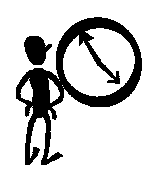|
Options
or Agendas
Criteria, Facts, Customers
Meeting Rules
Measuring Results |
 Meetings
Rules - The Basics Meetings
Rules - The Basics
In the 2000 decade I conducted seminars for senior executives
who wanted to improve how their teams worked together
and surprisingly, key issues in every session were how
to run meetings and once a decision was made, to improve
accountability. With close to 1000 executives views, here are the
basics people expect. You will find more of that research
in my best practice
guide.
How to Run a Meeting
- Publish an agenda ahead of meeting.
- Aggressively debate, ask questions, be the contrarian,
actively listen.
- Don't interrupt each other. Everyone's opinion counts.
- Have a time limit.
- Be fair.
- Have a "hanging issues" or "parking
lot" flip chart to move an item off the table
for a while.
- Have a mechanism for folks to acknowledge the understand
someone's opinion, maybe by vote or a small flag you
display, to politely end a discussion.
- Come back to the "hanging issues" towards
the end of the discussions to determine if you need
to revisit one or it has been resolved. Remember, the
future is uncertain and there will be ambiguities.
- In the last round, everyone has to publicly agree
or disagree. No silent dissent (passive aggressive behavior).
How to improve accountability
A very frustrating outcome of strategic planning meetings
is that you think you have agreement around the table
on what is to be done and who will do it, but a month
later someone "recalls" that they were not
accountable. Folks commonly agree to a concept in a meeting
but do not explicitly accept accountability to execute.
The solution to get people to be accountable involves
how you run and finish a meeting — a leadership
approach which respects the integrity and experience
of those at the meeting.
First, here are six fundamentals on how to conduct
decision meetings so the participants want to be accountable
for the outcomes:
- Ensure those who will be accountable are in the meeting!
- At the start of the meeting before confirming the
agenda, ensure everyone knows that the purpose of the
meeting is to make decisions and to assign responsibility
and accountability.
- Ask those attending "can you make the decision
or do you have to get someone else's permission?" If
they are not empowered, call their boss and make sure
they are.
- As the meeting progresses, ask if there are concerns
or objections. Keep a list of these issues that everyone
can see.
- At each milestone in the discussion be clear about
accountability, responsibility and specific objectives
(confirm and clarify) and then link an individual's
tasks to everyone else's tasks.
- Keep a running summary what needs to be done and
who is responsible and accountable on a flip chart,
whiteboard or PowerPoint presentation. Sometimes others
may be responsible to carry out the work, but the person
at the meeting must be accountable for its completion.
Second, there are two steps to end the meeting: the
confirmation process and the boss acknowledgment of the
assignments eyeball to eyeball.
The confirmation process involves committing to the
agreement starting with the most junior person and progressing
to the most senior. Ensure that any objections, concerns
or uncertainties are expressed and resolved, or people
can avoid publicly buying in. Once the more junior folks,
usually those with most of the action items, think their
boss or another boss is done, they can stay quiet and
avoid responsibility. Refer back to the list of list
of concerns, have the all be satisfied or at least discussed.
Once everyone has the opportunity to resolve their issues
or have them acknowledged, you then ask publicly "do
you buy in."
If the meeting is of great importance, ask the boss
to attend the final part of the meeting, summarize the
agreement and get his or her buy off.
 Members,
Attitude, Approach Members,
Attitude, Approach |
|
Measuring
Results  |
|